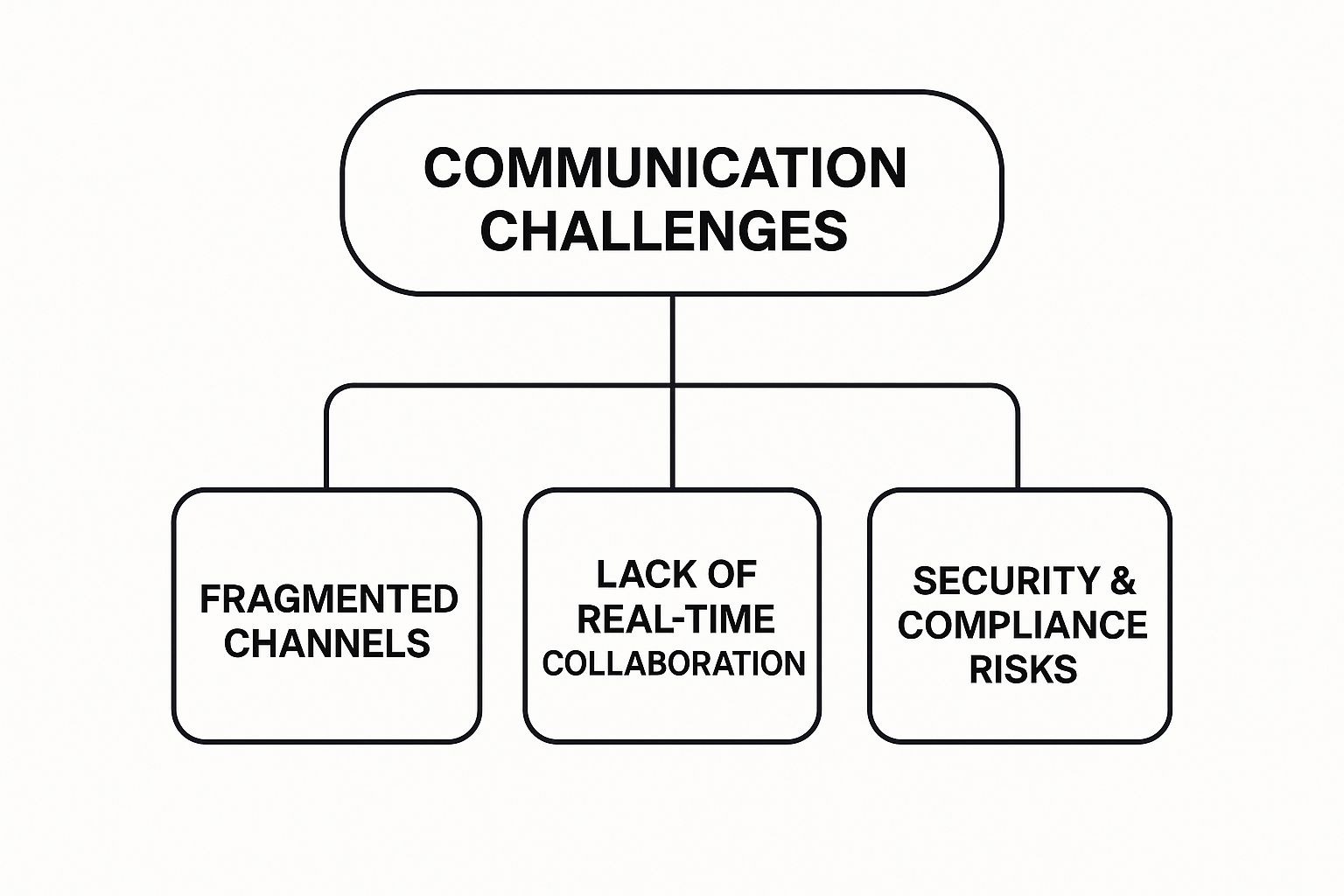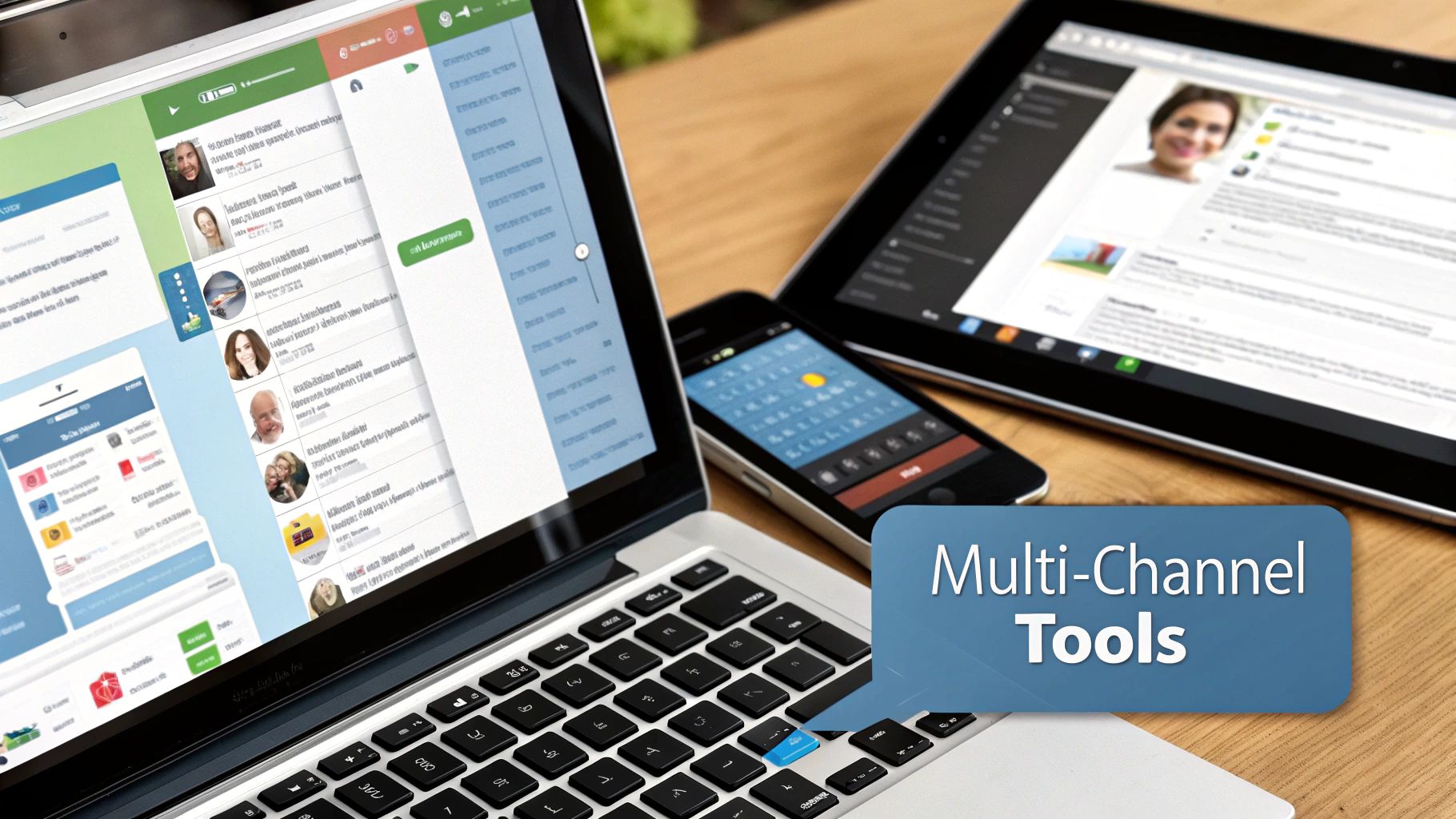At its core, a business communication solution is the central nervous system of your company. Think of it as the complete set of tools and platforms that manage how your team talks to each other internally, and how the business as a whole speaks to the outside world—whether it's customers, partners, or suppliers.
What Are Modern Business Communication Solutions?

Remember the old landline phone? Its job was simple: make and receive calls. That was it. Now, think about your smartphone. It’s a powerhouse for calls, texts, emails, video chats, and countless apps, all in one place. That same leap forward has happened in the world of business communication.
It wasn't long ago that business communication was completely siloed. You had a separate phone system for calls, an email server for messages, and maybe a fax machine humming away in the corner. Each tool was an island, leading to clunky processes and lost information. In today’s fast-paced world, that fragmented approach just doesn't cut it for any business that wants to be efficient and grow.
The game has changed. Modern business communication solutions are all about integration. They weave different channels—voice, video, messaging—into a single, tidy system, making sure information flows seamlessly right across your organisation.
The Rise of Unified Communications
This all-in-one approach is what we often call Unified Communications as a Service (UCaaS). UCaaS platforms bring all your essential communication tools together into one service that lives in the cloud. This means you can access everything from anywhere you have an internet connection, ditching the need for expensive hardware in your office and wrapping it all up in a predictable monthly subscription.
So, what’s inside a modern solution? You’ll typically find:
- Voice over IP (VoIP): This lets you make phone calls over the internet, which is often cheaper and far more flexible than a traditional phone line.
- Team Messaging: Think instant chat for your team, allowing for quick questions, file sharing, and keeping projects on track in real-time.
- Video Conferencing: For holding face-to-face meetings with colleagues or clients, no matter where they are in the world.
- Multi-channel Customer Support: A single hub to manage conversations coming from phone calls, emails, social media, and more.
A truly effective business communication solution acts as the digital backbone for your company. It ensures every team member has the right information at the right time, empowering them to make smarter decisions and deliver exceptional customer experiences.
Why Centralised Systems Are Now Essential
The push for integrated, scalable systems isn’t a new phenomenon. Businesses have been wrestling with these issues for decades. Even back in the late 1990s, companies could see communication getting more complex. As a result, systems were designed to handle more data and manage more sophisticated workflows across different channels. You can discover more insights about what has historically driven communication technology forward.
For any UK business today, particularly small and medium-sized ones, a centralised system isn't a luxury anymore. It's a must-have for staying competitive. It smooths out your operations, gives productivity a real boost, and makes sure your business looks professional and organised to every single customer.
The Anatomy of a Modern Business Communication System
Building a robust communication system for your business today isn't just about getting a phone line. It's more like putting together a high-performance engine; you need a specific set of parts that are designed to work together seamlessly. Each component has its job, but it's how they combine that creates a system powerful enough to drive your business forward.
Think of it this way: if your company were a person, these tools would be its eyes, ears, and voice, all working in perfect sync. The real goal is to get rid of fragmented conversations and create a single, organised stream of information—both for your internal team and for your customers. This is the foundation for solving those all-too-common communication headaches.
The image below shows some of the typical challenges that businesses run into when they're stuck with outdated or disconnected communication tools.

As you can see, problems like scattered communication channels and clunky collaboration don't just cause frustration; they create genuine risks and inefficiencies. So, let’s unpack the specific tools that form the bedrock of a system designed to fix these very issues.
To really understand what makes up a modern solution, it's helpful to break down the core components. The table below outlines these essential features, what they do, and why they matter for your business.
Core Features of Modern Business Communication Solutions
| Component | Primary Function | Key Business Benefit |
|---|---|---|
| VoIP Business Phones | Routes calls over the internet instead of traditional phone lines. | Reduces costs, increases flexibility (calls on any device), and ensures you never miss a call. |
| Team Collaboration Hubs | Provides a central space for internal messaging, file sharing, and project work. | Cuts down on email clutter, speeds up internal decision-making, and keeps teams aligned. |
| Omnichannel Inbox | Unites customer messages from different channels (email, social, chat) into one view. | Creates a seamless customer experience and ensures any team member can handle an enquiry with full context. |
| CRM Integration | Connects the communication platform with your Customer Relationship Management system. | Provides rich customer context during conversations, leading to more personalised and effective support. |
| Analytics & Reporting | Tracks key metrics like call volume, response times, and customer satisfaction. | Offers data-driven insights to improve team performance and refine your communication strategy. |
These components are the building blocks. When they're properly integrated, they create a cohesive system that's far more powerful than the sum of its parts.
The Tools That Power Your Internal Dialogue
These are the tools that grease the wheels of your internal operations. They are the digital equivalent of a well-designed office, built to keep everyone on the team connected and in the loop, no matter where they’re working from.
- VoIP Business Phone Systems: Voice over Internet Protocol, or VoIP, has become the standard for business calls, and for good reason. Instead of being tied to old-fashioned landlines, VoIP uses your internet connection. This makes it incredibly flexible and much more cost-effective. You can take calls from your desk phone, your laptop, or your mobile, meaning you're always available when it matters.
- Team Collaboration Platforms: Think of these as your company's virtual headquarters. Tools like Slack or Microsoft Teams create a central hub for instant messaging, sharing files, and organising conversations around specific projects. They dramatically reduce inbox clutter and make getting a quick answer from a colleague incredibly simple.
The Channels That Connect You to Your Customers
How your business talks to the outside world is every bit as important as how it talks to itself. Having the right customer-facing tools helps you present a professional, responsive front that builds real trust and lasting loyalty. A guiding principle here is simple: meet your customers on the channels they already use and prefer.
According to a study from FlexOS, a staggering 30% of employees feel frustrated by a lack of clear communication from their managers. A great system not only makes internal tasks clearer but also ensures everyone is delivering the same consistent message to customers.
This is where an omnichannel approach truly shines. It’s all about bringing together your different customer communication streams—email, social media DMs, live chat, WhatsApp messages—into a single, shared inbox. This means any team member can jump into a conversation and immediately have the full history. No more asking customers to repeat themselves. It’s a complete game-changer for delivering seamless support and creating an experience that puts the customer at the very centre of your operation.
Why Better Communication Is a Smart Investment

Adopting new technology can often feel like a big leap. But the right business communication solutions aren't just another line on your expense sheet; they're a direct investment in your company's long-term health and growth. The payback shows up in real, measurable ways, from healthier profit margins to happier customers who stick around.
One of the most immediate gains is simply cutting costs. Take a moment to think about your current setup. You're likely juggling separate landline contracts, a video conferencing subscription, and maybe even a collection of different mobile plans. A unified solution rolls all of these into one, slashing supplier overheads and doing away with the need for clunky, office-based hardware.
Unlocking Team Productivity
It goes far beyond just saving money, though. These solutions fundamentally change how your team works together day-to-day. When key information gets trapped in different apps or buried in endless email chains, you create what are known as "information silos." This is particularly damaging for hybrid and remote teams where seamless communication is the very fabric holding the operation together.
By breaking down these barriers, you naturally create a more collaborative atmosphere. Imagine a team member turning a quick project chat into an instant video call to thrash out a problem, all without leaving the same app. This kind of smooth, frictionless workflow gets rid of frustrating delays, boosts morale, and lets your people focus on their actual jobs instead of just chasing updates.
A well-structured communication system ensures your team isn't just talking, but connecting. It empowers them with the context and tools needed to support each other and, most importantly, your customers.
Building Stronger Customer Relationships
This newfound internal efficiency has a direct and powerful impact on the customer experience. When your team has the right tools at their fingertips, they can provide the kind of quick, consistent support that builds genuine loyalty.
Think about it: a customer calls with a problem, and your team member can instantly see their entire history with your business—previous calls, recent emails, the lot—all in one place. No more making customers repeat themselves. It means faster resolutions and a much better impression of your company.
This level of connectivity is fast becoming the standard across the UK. In fact, the market for fixed connectivity, a cornerstone of modern business communication solutions, is on track to reach an estimated value of USD 3.72 billion by 2030. This isn't just a random number; it signals a major shift towards digital-first operations where great communication underpins everything from internal workflow to customer satisfaction. You can read the full research about UK B2B connectivity trends to explore this further.
How to Choose the Right Business Communication Solution
Right, so you're faced with a sea of options for business communication solutions. Where do you even begin? It can feel a bit daunting, but picking the right setup for your company doesn't have to be a headache. The trick is to sidestep the one-size-fits-all sales pitches and focus on what your business actually needs to thrive.
Let's be honest, what works for a massive corporation with thousands of employees is almost certainly overkill for a local UK shop. The first step is to take a good, hard look at how you're communicating right now. Where are the weak spots? Are you losing track of customer messages because they're scattered across personal mobiles and a handful of social media accounts? Is your remote team finding it a pain to work together effectively? Getting a clear picture of what's broken is the only way to find a proper fix.
Figure Out Your Goals and Essential Features
Once you've diagnosed the problems, you can start thinking about what you want to achieve. Is the main goal to give your business a more professional polish? Or are you simply trying to slash that eye-watering monthly phone bill? Perhaps you're scaling up and need a system that supports a hybrid team, keeping everyone connected whether they're in the office or working from their kitchen table.
Your goals will point you directly to the features that matter most. If brilliant customer service is your top priority, you’ll want a solution that integrates smoothly with your CRM and brings all your customer conversations into one place. For a business with staff all over the country, reliable video calls and a shared messaging hub are absolute must-haves.
A simple checklist can be a lifesaver here. Split it into two columns: "must-haves" and "nice-to-haves." This little document will become your North Star as you start comparing providers.
- For a small retail business: A virtual number for WhatsApp Business and simple call forwarding could be the game-changers.
- For a team of consultants: Secure file sharing and crystal-clear video conferencing are probably non-negotiable.
- For an e-commerce store: Look for seamless integration with your sales platform and tools for automating customer replies.
What to Look for in a Provider
With your priorities mapped out, you can start weighing up the different providers. It's easy to get distracted by flashy marketing, but it's the fundamentals that really count for a dependable, secure service for your UK business.
Here's a piece of advice I always give: Don’t just choose a solution for the business you have today; choose one for the business you want to become. Scalability is everything—the right system should grow with you, not hold you back.
Keep these key factors in mind as you do your research:
-
Scalability: How easily can you add more users or phone numbers when your team grows? You don't want a system that needs a complete, costly overhaul just because you hired your third employee.
-
Integration Capabilities: Does it connect nicely with the other software you use every day? Think about your CRM, project management tools, or e-commerce platform. When your systems talk to each other, you save a huge amount of time and avoid crucial data getting stuck in silos.
-
Security and Compliance: This is a big one. The provider absolutely must comply with UK data protection laws like GDPR. Look for assurances like end-to-end encryption to keep your business conversations and customer data safe.
-
Customer Support: When things go wrong—and sooner or later, they will—you need to know you can get fast, helpful support. Read the reviews. See what other UK businesses are saying about their helpdesk. A great support team isn't a bonus; it's a necessity.
Seeing Communication Solutions in Action

It’s one thing to talk about features and benefits, but it’s another thing entirely to see how business communication solutions solve real-world problems for UK businesses. Moving from theory to practice really helps to picture how these tools could work in your own organisation, tackling the unique challenges you face every day.
These tools aren't just for massive corporations; they offer tremendous value for small and medium-sized enterprises across every sector imaginable. Whether you run a high-street shop or a specialised consultancy, the right setup can make a world of difference. The trick is to apply them to solve a specific, nagging problem.
The UK's reliance on solid communication infrastructure is plain to see. The national telecom services market is a powerhouse, with mobile data services making up nearly 38% of the total revenue. This really shines a light on how vital mobile and data-driven tools have become for remote work, cloud software, and the real-time collaboration these examples rely on. You can discover more insights about UK telecom market trends and see how this shift is shaping modern business.
Industry-Specific Scenarios
Let's ground this in reality. Here are a few practical examples of how different businesses are putting these solutions to work.
For a Retail Business
Imagine a customer sends a WhatsApp message asking if a particular pair of shoes is in stock in their size. Instead of a delayed reply, an integrated system lets a shop assistant check the inventory directly from their chat dashboard. They can confirm it's available, send a quick photo of the shoes, and even share a secure payment link—all within the same conversation.
- Problem Solved: Lost sales due to slow responses and clunky stock-checking processes.
- Result: A quick, seamless customer experience that often converts a simple query into an immediate sale.
For a Healthcare Clinic
A busy clinic uses a secure messaging service that’s linked directly to its appointment system. It automatically sends out reminders, which drastically reduces the number of no-shows. After a consultation, the system can follow up with a message containing post-care instructions and a simple link to book a future check-up, all while keeping sensitive patient data completely confidential.
Using secure, automated messaging doesn't just improve efficiency behind the scenes. It gives patients timely, valuable information, which builds trust and encourages them to take a more proactive role in their own health.
For a Professional Services Firm
A team of consultants is working with a client on a sensitive project. They use a unified platform that combines high-definition video conferencing for their weekly progress meetings with a secure portal for sharing documents. This setup ensures every conversation and file is encrypted and stored in one central, auditable location, protecting both the firm's and the client's data.
- Problem Solved: Risk of data breaches from using insecure, consumer-grade apps for client work.
- Result: Enhanced client trust and full compliance with data protection regulations.
Practical Example: Getting a Business Number for WhatsApp
Right, so you want to get your business on WhatsApp, which is a brilliant move. After all, that's where your customers are hanging out. But using your personal mobile number? That's a definite no-go. It muddles your work and private life and, let's be honest, it doesn't scream professionalism. This is precisely where a virtual number steps in to save the day.
Think of a virtual number as a phone number that lives in the cloud, not on a physical SIM card. It works entirely over the internet, funnelling calls and messages through an app on your existing smartphone. For any UK business owner, this is a game-changer. You get a dedicated business line without needing another phone or juggling multiple SIMs.
The magic of a virtual number really boils down to one thing: separation. It lets you carve out a proper business identity on WhatsApp, keeping your personal number just for you. It's a simple change that makes a huge difference to your work-life balance.
A Practical Guide to Getting Started
Getting your business set up on WhatsApp with a virtual number is surprisingly straightforward. It’s one of the most practical and powerful business communication solutions you can implement, and you can do it in an afternoon.
Here’s a simple, step-by-step walkthrough to get you up and running:
-
Choose a Virtual Number Provider: First things first, you need a provider. Look for one that specialises in virtual numbers for WhatsApp Business, like Business Numbers Direct. You'll want a service that’s simple, has no long-term contracts, and can get you activated in minutes.
-
Select and Activate Your Number: Now for the fun part – pick a UK mobile number that will become your new business line. Activation should be almost instant, usually just requiring a quick verification to prove it's you.
-
Link to WhatsApp Business: Download the WhatsApp Business app if you haven't already. When it prompts you for a phone number during setup, pop in your new virtual number. You’ll get a verification code sent to your provider's app—enter that code into WhatsApp, and you're officially connected.
Setting Up for Success
Once you're linked, it's time to make your profile look the part. Don't skip this step! Fill out your business profile with your address, opening hours, and a link to your website. You can even create a product catalogue right inside the app, which is incredibly handy for customers.
Finally, make the most of the automation tools. Set up Quick Replies for frequently asked questions to save yourself from typing the same thing over and over. Use Away Messages to let people know when you’ve clocked off for the day. These little touches show you're running a professional operation and keep customers happy, even when you're not there to reply instantly.
Frequently Asked Questions
Stepping into the world of modern business communication solutions can feel a little daunting at first, especially when you're used to the old ways of doing things. It's only natural to have a few questions, so we've put together some straightforward answers to the queries we hear most often from UK business owners.
What Is the Real Difference Between VoIP and a Landline?
Think of it this way: a traditional landline is like being tethered to the wall. It relies on a physical network of copper wires, which makes it reliable but also rigid and often surprisingly expensive.
VoIP, or Voice over Internet Protocol, cuts that cord. It works by turning your voice into a digital signal that travels over your internet connection. This simple shift opens up a world of possibilities, making it more affordable, flexible, and feature-rich. Your business number can now follow you anywhere with an internet connection, and you get modern tools like video calling and voicemail-to-email that old landlines just can't handle.
Is Unified Communication Worth It for a Small Business?
Without a doubt. In the past, this kind of tech was reserved for big corporations, but today's unified solutions are affordable and give small businesses a serious competitive advantage. They let you punch well above your weight, projecting a polished, professional image.
The real magic is in bringing everything together. By bundling your phone, messaging, and video conferencing into a single, easy-to-use platform, you often end up saving money. More importantly, it helps a small team manage customer interactions with the efficiency of a much larger company, ensuring no opportunity ever falls through the cracks.
How Secure Are Cloud-Based Communication Systems?
This is a great question, and the answer is that any provider worth their salt puts security front and centre. When you're comparing services, there are a few non-negotiables to look for: end-to-end encryption for all your calls and messages, secure UK-based data centres, and full compliance with regulations like GDPR.
Properly managed, these systems are significantly more secure than letting staff use their personal apps for work. You get centralised control over your company's sensitive data and a clear overview of all communications, giving both you and your customers complete peace of mind.
Ready to create a professional, private, and powerful communication channel for your customers on WhatsApp? Get your dedicated virtual number from Business Numbers Direct in under five minutes. Start your journey for just £7.99 per month with no contract.




